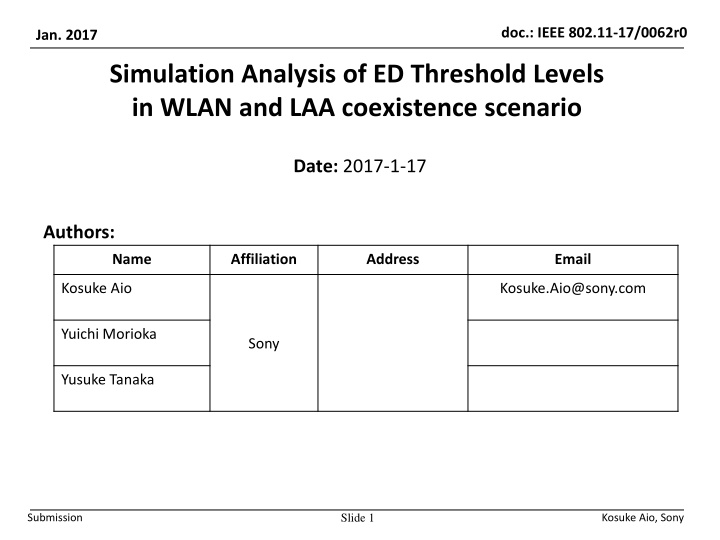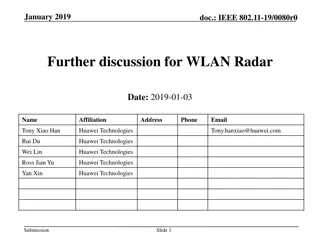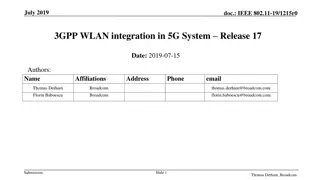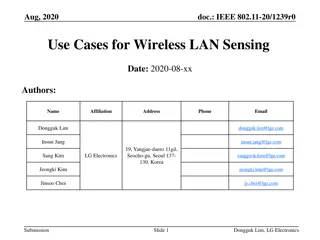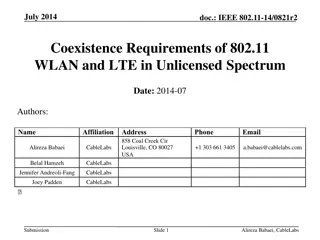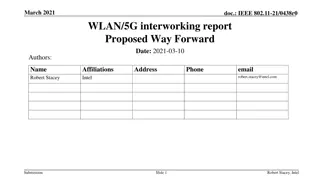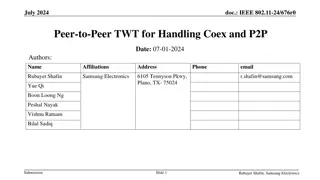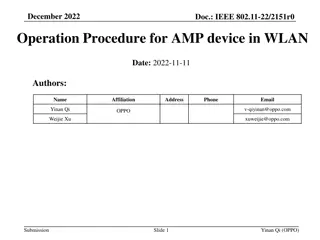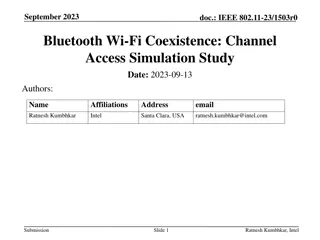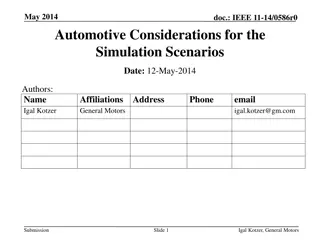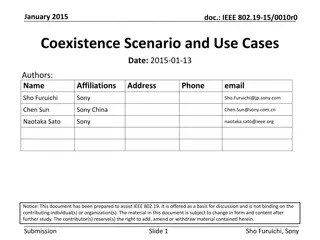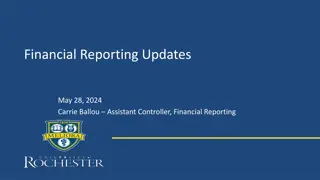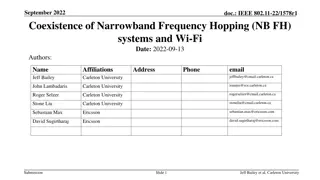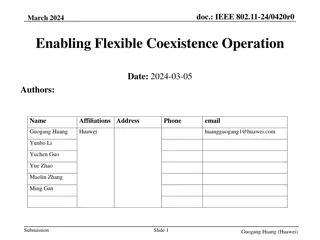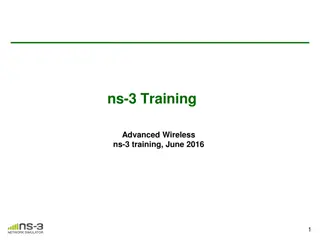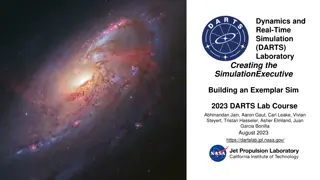Simulation Analysis of ED Threshold Levels in WLAN and LAA Coexistence
IEEE 802.11-17/0062r0 presents a simulation analysis of ED threshold levels in WLAN and LAA coexistence scenarios. The study evaluates the impact of different ED thresholds on the performance of Wi-Fi and LAA technologies. Through simulation scenarios based on 3GPP TR 36.889, the presentation explores the outcomes when both LAA and Wi-Fi operate at -72dBm without PD communication and assesses the effects of Wi-Fi utilizing dynamic TX power and ED threshold control methods.
Download Presentation

Please find below an Image/Link to download the presentation.
The content on the website is provided AS IS for your information and personal use only. It may not be sold, licensed, or shared on other websites without obtaining consent from the author.If you encounter any issues during the download, it is possible that the publisher has removed the file from their server.
You are allowed to download the files provided on this website for personal or commercial use, subject to the condition that they are used lawfully. All files are the property of their respective owners.
The content on the website is provided AS IS for your information and personal use only. It may not be sold, licensed, or shared on other websites without obtaining consent from the author.
E N D
Presentation Transcript
doc.: IEEE 802.11-17/0062r0 Jan. 2017 Simulation Analysis of ED Threshold Levels in WLAN and LAA coexistence scenario Date: 2017-1-17 Authors: Name Affiliation Address Email Kosuke Aio Kosuke.Aio@sony.com Yuichi Morioka Sony Yusuke Tanaka Slide 1 Submission Kosuke Aio, Sony
doc.: IEEE 802.11-17/0062r0 Jan. 2017 Introduction (1) IEEE 802.11 WG established the PDED ad hoc to consider potential response to 3GPP RAN1 s request to change WLAN s ED threshold from -62dBm to -72dBm IEEE802.11-16/1291r0 [1] mentions that at least three experiments (by simulation and/or testing) are suggested to provide the basis to respond to the 3GPP RAN1 request In November 2016 meeting at San Antonio, we analyzed case B) some 802.11 STA uses ED of -72dBm , where 802.11ax STAs use the new threshold in IEEE802.11-16/1451r0 [2] Slide 2 Submission Kosuke Aio, Sony
doc.: IEEE 802.11-17/0062r0 Jan. 2017 Introduction (2) In this presentation, we further analyze using simulation scenario defined in 3GPP indoor scenario corresponding to TR36.889 [3] We analyze the performance of 802.11 in these two cases; (1) What happens if both LAA and Wi-Fi operate at ED of - 72dBm but with no PD communication (2) What happens if Wi-Fi operates using Dynamic TX power and ED threshold control method Slide 3 Submission Kosuke Aio, Sony
doc.: IEEE 802.11-17/0062r0 Jan. 2017 (1) Simulation results on What happens if both LAA and Wi-Fi operate at ED of -72dBm but with no PD communication Slide 4 Submission Kosuke Aio, Sony
doc.: IEEE 802.11-17/0062r0 Jan. 2017 Simulation Scenario Simulation scenario is based on 3GPP TR 36.889 [3] Indoor scenario for LAA coexistence evaluations within unlicensed band. <Layout of nodes> LAA WLAN Active Nodes BS x 4, MS x 20 BS x 4, MS x 20 Traffic Model & Load Next slide CWmin=15, CWmax=63, m=3, Tm cot=0 CWmin=15, CWmax=1023, AIFSN=3, TXOP limit=0 Channel Access Parameter (Appendix.1) MCS 5 (Fixed) Frequency 5,180MHz Bandwith 20MHz Blue is LAA BS (eNB). Green is WLAN BS (AP). WLAN and LAA Mobile Stations (MS) are dropped randomly in this area. (20 drops) Max TX Power [dBm] BS:+18, MS:+18 BS:+18, MS:+18 Antenna Gain [dBi] BS:+5, MS:0 BS:+5, MS:0 Detect Th [dBm] (PD,ED) = (NA, -72) Next slide Note : 11ax and LAA features such as OFDMA /Multi-user /HARQ are not enabled in this simulation to see the pure performance of channel access. Submission Slide 5 Kosuke Aio, Sony
doc.: IEEE 802.11-17/0062r0 Jan. 2017 Simulation Setup We set simulation setups as follows. Traffic Model & Load WLAN Detect Th [dBm] Default Setup WLAN : (PD,ED) = (-82, -62) Heavy Traffic Model FTP model 1 UDP (file size : 0.5Mbyte, lambda : 2.5) <DL> 20flows <UL> No traffic (1) (A) 3GPP Requested Setup WLAN : (PD,ED) = (-82, -72) (2) Default Setup WLAN : (PD,ED) = (-82, -62) (1) Light Traffic Model CBR UDP (75kbps) (B) 3GPP Requested Setup WLAN : (PD,ED) = (-82, -72) <DL> 75kbps 20flows <UL> No traffic (2) * (A) FTP model 1 UDP is default traffic model defined for 3GPP indoor scenario corresponding to TR36.889 [3]. This FTP model is described in 3GPP TR 36.814 [4]. * (B) CBR UDP with 75kbps traffic load is used in the simulation for R1-156621[5]. Slide 6 Submission Kosuke Aio, Sony
doc.: IEEE 802.11-17/0062r0 Jan. 2017 What s LAA s ED rule? According to LAA s ED rule in 3GPP TS 36.213 [6], LAA can control ED threshold by maximum output power. (Appendix.2) However, the ED threshold is static once maximum output power is selected Maximum output power is determined by rated output power declared by the manufacturer, and it can not change during operation Therefore, LAA s and WLAN s ED threshold in this simulation is as follows. LAA s ED is set to -72dBm (fixed) because LAA BS s maximum output power is 23dBm including antenna gain. In (1) Default Setup, WLAN s ED threshold is set to -62dBm (fixed). In (2) 3GPP Requested Setup, WLAN s ED threshold is set to -72dBm (fixed) for the same reason as LAA s BS. Slide 7 Submission Kosuke Aio, Sony
doc.: IEEE 802.11-17/0062r0 Jan. 2017 Simulation Result : (A) FTP model 1 UDP Ave. DL Throughput per flow [Mbps] Setup LAA WLAN (1) 1.46Mbps 2.64 Mbps (2) 2.23Mbps 1.80 Mbps - If WLAN ED changes to -72dBm (fixed), Ave. DL throughput of LAA is higher than that of WLAN due to difference of channel access, such as CWmax. Slide 8 Submission Kosuke Aio, Sony
doc.: IEEE 802.11-17/0062r0 Jan. 2017 Simulation Result : (A) FTP model 1 UDP Each BS Ave. DL Throughput per flow [Mbps] - There is LAA BS that is muted in (1) Default Setup. - Even if WLAN s ED threshold changes to -72dBm, the performance of the muted BS is not improved Slide 9 Submission Kosuke Aio, Sony
doc.: IEEE 802.11-17/0062r0 Jan. 2017 Simulation Result : (B) CBR UDP (75kbps) Ave. DL Throughput per flow [Mbps] Setup LAA WLAN (1) 75.0kbps 75.0kbps (2) 75.0kbps 75.0kbps - LAA and WLAN average DL throughput is the same between two simulation setups (1) and (2) due to low traffic Slide 10 Submission Kosuke Aio, Sony
doc.: IEEE 802.11-17/0062r0 Jan. 2017 Simulation Result : (B) CBR UDP (75kbps) Each BS Ave. DL Throughput per flow [Mbps] - Average throughput of all BS is same at 75kbps. Slide 11 Submission Kosuke Aio, Sony
doc.: IEEE 802.11-17/0062r0 Jan. 2017 Conclusion From these simulation results, it can be observed that meeting 3GPP request is not a way to provide fair coexistence between LAA and WLAN especially in heavy networks, from the following two reasons; When WLAN uses the same ED threshold of -72dBm, throughput of LAA become higher than that of WLAN due to difference of channel access scheme. Furthermore, the lowest performance of LAA BS is not improved even if WALN changes ED threshold to -72dBm. Therefore, we need to consider other method to provide fair coexistence From next slide, we analyze dynamic TX power control and ED Threshold control to solve this problem Slide 12 Submission Kosuke Aio, Sony
doc.: IEEE 802.11-17/0062r0 Jan. 2017 (2) Simulation results on What happens if Wi-Fi operates using Dynamic TX power and ED threshold control method Slide 13 Submission Kosuke Aio, Sony
doc.: IEEE 802.11-17/0062r0 Jan. 2017 Dynamic TX Power and ED Threshold Control Current LAA s ED Threshold is fixed by maximum output power Maximum output power can be lowered but that will result in smaller coverage We analyze Dynamic TX power and ED threshold control for WLAN WLAN adjusts TX power according to anticipated recipient WLAN adjusts ED threshold by current TX power WLAN BS ED-th(dBm) Low TX power High ED threshold -62 High TX power Low ED threshold WLAN MS_1 WLAN MS_2 -72 WLAN MS_2 (far from BS) Current TX Pow(dBm) WLAN MS_1 (near from BS) 23 13 Slide 14 Submission Kosuke Aio, Sony
doc.: IEEE 802.11-17/0062r0 Jan. 2017 Simulation Setup Simulation setup is as follows (A)/(1)/(2) are the same as before Traffic Model & Load WLAN Detect Th [dBm] Default Setup WLAN : (PD,ED) = (-82, -62) (1) 3GPP Requested Setup WLAN : (PD,ED) = (-82, -72) (2) FTP model 1 UDP (file size : 0.5Mbyte, lambda : 2.5) <DL> 20flows <UL> No traffic (A) Proposed Setup - WLAN : PD = -82 WLAN : ED = variable. (determined by current TX power) - Target RSSI = -52 ( ) (3) - * TX power [dBm] = Target RSSI [dBm] Path Loss [dB] (On the assumption that WLAN can get information about Path Loss between BS and MS) Slide 15 Submission Kosuke Aio, Sony
doc.: IEEE 802.11-17/0062r0 Jan. 2017 Simulation Result Ave. DL Throughput per flow [Mbps] Setup LAA WLAN (1) 1.46Mbps 2.64 Mbps (2) 2.23Mbps 1.80 Mbps (3) 2.00Mbps 2.08Mbps - If WLAN controls TX power and ED threshold, Ave. DL throughput of LAA and WLAN become comparable because WLAN can increase ED threshold Slide 16 Submission Kosuke Aio, Sony
doc.: IEEE 802.11-17/0062r0 Jan. 2017 Simulation Result Each BS Ave. DL Throughput per flow [Mbps] - If WLAN controls TX power and, the lowest throughput of LAA BS is improved because WLAN BS reduces the TX power Slide 17 Submission Kosuke Aio, Sony
doc.: IEEE 802.11-17/0062r0 Jan. 2017 Conclusion By this simulation result, Dynamic TX power and ED threshold control is the best solution to provide fairness between WLAN and LAA - If WLAN can control TX power and ED value, DL throughput of LAA BS and WLAN AP become comparable - Furthermore, the lowest performance of LAA BS is improved by proposed method Slide 18 Submission Kosuke Aio, Sony
doc.: IEEE 802.11-17/0062r0 Jan. 2017 References [1] 11-16-1291-00-0000-pded-ad-hoc-agenda-27-sept-2016 [2] 11-16-1451-00-0000-Simulation-Analysis-of-ED-Threshold- Levels [3] 3GPP TR 36.889 V13.0.0 [4] 3GPP TR 36.814. [5] R1-156621(Coexistence Simulation Results for DL-only LAA) [6] 3GPP TS 36.213 V14.0.0 (2016-09) Slide 19 Submission Kosuke Aio, Sony
doc.: IEEE 802.11-17/0062r0 Jan. 2017 Appendix Slide 20 Submission Kosuke Aio, Sony
doc.: IEEE 802.11-17/0062r0 Jan. 2017 Appendix 1. LAA channel access model [6] Need to TX? Initial CCA Yes Yes Channel idle for Td? Transmit No Update CW based on HARQ-ACK Generate random number N out of [0,CW] Extended CCA No Channel idle for Td? Yes Td=16 s+mp*Tsl Tsl=9 s Yes N=0? No N=N-1 Yes No Channel idle for Tsl? Slide 21 Submission Kosuke Aio, Sony
doc.: IEEE 802.11-17/0062r0 Jan. 2017 Appendix 2. LAA ED rule Excerpt from 3GPP TS 36.213[6]/15.2.3.1 Default maximum energy detection threshold computation procedure = X + 10 , T dB max ' min X where Thresh_max If the higher layer parameter absenceOfAnyOtherTechnology-r14 indicates TRUE: r Eq(1) X is Maximum energy detection threshold defined by regulatory requirements in dBm when such - + 10 , T dB r max = ' min X where Thresh_max = + 10 X T dB X requirements are defined, otherwise max r r otherwise - otherwise Eq(2) X is Maximum energy detection threshold defined by regulatory requirements in dBm when such + = P T T log 10 max r + T , 72 10 log 10 ( / 20 ) 10 , BWMHz MHz 72 dBm log 10 ( / 20 ) , BWMHz MHz dBm = X + max 10 = X T ' dB max requirements are defined, otherwise max ' max _ Thres max Thres r - , T X Where max _ min max is the set to the value of PCMAX_H,cas defined in [6]. ) ( min + + 10 TX P log ) 10 ( / 20 ) T T MHz 20 P BWMHz - MHz P ( P - + + H ) 10 ( max / BWMHz A TX Where TX A H T = 10dB otherwise A / ( ) = 10 log10 3.16228 10 ( T = 10dB Where 8 max(dBm) T ) ( ) mW MHz BWMHz MHz - - ; A P = 23 dBm; - H + T , 72 10 log 10 ( / - 20 ) , BWMHz MHz BWMHz is the single carrier bandwidth in MHz. dBm P = 23 dBm; - H P - is the set to the value of PCMAX_H,cas defined in [6]. = ' max X - TX max Thres P _ max min ) ( - is the set to the value of PCMAX_H,cas defined in [6]. + + 10 log 10 ( / 20 ) T ( T P BWMHz MHz ) ) P TX ( ) max A H TX = 10 log10 3.16228 10 ( 8 max(dBm) T / ) ( ) mW MHz BWMHz MHz - ; Slide 22 BWMHz MHz Submission max(dBm) T Kosuke Aio, Sony = 10 log10 3.16228 10 ( 8 / ) ( mW MHz - ; Where - BWMHz is the single carrier bandwidth in MHz. - BWMHz is the single carrier bandwidth in MHz.
doc.: IEEE 802.11-17/0062r0 Jan. 2017 Appendix 2. LAA ED rule In that case of WLAN and LAA coexistence, LAA s ED threshold is calculated by Eq(2). If BW = 20MHz, LAA s ED threshold is as follows. Slide 23 Submission Kosuke Aio, Sony
doc.: IEEE 802.11-17/0062r0 Jan. 2017 Appendix 3. Traffic Model We compare between difference ED threshold under two traffic model. (A) FTP model 1 UDP This is default traffic model following 3GPP indoor scenario corresponding to TR36.889 [3]. This traffic model is used in the simulation on R1-156621 (Coexistence Simulation Results for DL-only LAA) [4]. This FTP model is described in 3GPP TR 36.814 [5]. This is regarded as heavy traffic, but isn t as full buffer. (B) CBR UDP (75kbps) This traffic model is used in the simulation on R1-156621 (Coexistence Simulation Results for DL-only LAA) [4]. This is regarded as very low traffic. Slide 24 Submission Kosuke Aio, Sony
